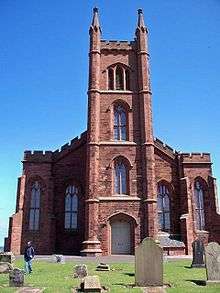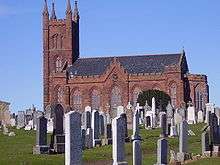Dunbar Collegiate Church

Dunbar Collegiate Church is renowned as having been the first collegiate church, in 1342, to have been established in the Lothians.[1] The church was situated on the same site as the present day parish church, on Queen's Road just south of Dunbar town centre.
History
The first mention of a church at Dunbar came in 1176 in the Taxatio of Lothian when the church was described as Eclessia de Dunbar. This church, dedicated to St. Bega, served the parish as a whole until 1342 and its foundation as a collegiate church.[2] On 21 April 1342, Patrick, 9th. Earl of Dunbar was granted. by charter, his right to the proprietorship of the church.[3] The church would have a dean, archdean and eight prebendaries with responsibility to Dunbar being Spott, Belton, Pinkerton, Linton, Chirnside, Dunse, Stenton and Pitcox.[4] The Dunbars were no strangers to the patronage of religious establishments with the foundation of a house of Trinity friars in 1218 then a monastery of Carmelite monks in 1263 by the 6th. and 7th. earls respectively. Dunbar Collegiate continued as decreed until it became forfeit to the crown in 1435. For a while the church was 'enjoyed' by the Duke of Albany during the reign of King James III of Scotland before returning to the Dunbars. In 1483, it, once again, reverted to the crown and stayed that way until the Protestant Reformation in 1560.[5]
Post Reformation

Dunbar Collegiate Church, unlike many other chapels, churches and monasteries in the area, was spared from the over zealous exploits of the people as they rejoiced in the popular fury, laying waste and burning anything associated with old faith. The old church became, once again, the parish church, this time of the reformed faith. Much repair and renewal work had been carried out over the years the building looked like a hybrid of Saxon, Gothic and Norman architecture. in 1779 the church was almost totally re-built. Then in 1819–1821, a new church was built and opened on 20 April 1821 with the Reverend John Jaffray the first minister at the new building. There is a magnificent monument in the church to a tireless servant of James VI and I, George Hume (1556–1611) Earl of Dunbar, High Treasurer of Scotland and Chancellor of the Exchequer of England.[5]
Noted Cleric
Columba de Dunbar became dean of the Collegiate Church in 1412 before taking up at the post of Bishop of Moray at Elgin Cathedral where he died in 1435. He is buried in the Dunbar Aisle at the great cathedral.[6]
See also
References
- ↑ http://www.rosslyntemplars.org.uk/index.php/scottish-collegiate-churches/dunbar Rosslyn Templars - Dunbar Collegiate Church
- ↑ Statistical Accounts of Scotland 1835
- ↑ http://www.rosslyntemplars.org.uk/index.php/scottish-collegiate-churches/dunbar Rosslyn Templars - Dunbar Collegiate Church/Full text of Foundation Charter
- ↑ https://archive.org/stream/churchofscotland02stor/churchofscotland02stor_djvu.txt History of Church of Scotland, Past and Present by Rev. Egbert Herbert D.D. (Edin.) ESA.
- 1 2 The History of Dunbar by James Miller (Dunbar)
- ↑ http://www.linleyfh.com/oursecondsite-p/p285.htm Hooper family site
External links
Coordinates: 55°59′57″N 2°30′42″W / 55.99911°N 2.51179°W